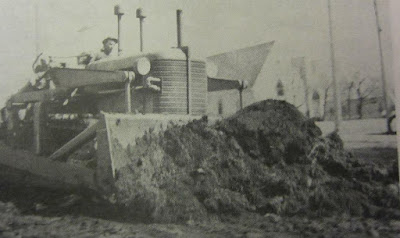 |
| An amazing picture but... It was taken in Winnipeg is 1918. I'd be glad to replace it with a picture of Reston local lawn bowlers if anyone has one! This one is in the Foote Collection at the Manitoba Archives in Winnipeg. |
Another recreational pastime for locals in the past was lawn bowling. A week’s free subscription to newspapers.com helped me find out a few things about its history in Reston. The Trails Along the Pipestone history book written in 1981 gives more details including where it took place.
Free Press Evening Bulletin April 27, 1926 The annual meeting of the Reston Lawn Bowling club was held last week with a good attendance. The club is in good financial standing. Jas F. McLaren has been appointed to look after the green. The following officers were elected: President, F. Manning; vice- president, Joe Sibbald; secretary-treasurer, Andy Ready.
Free Press Evening Bulletin --August 1, 1927 Two rinks of Virden Lawn Bowlers visited Reston Thursday afternoon and evening. The home team won both games with total of 88 points against 19 by the visitors. The rinks were: Virden: Hammond, Patterson, McKnight. Capt. Smith, skip. 6. Reston: Wynn, Caldwell. Wilkins, McLaren, skip, 22. Virden Squires: Hand, Fitzpatricks, Dickinson, skip. 13. Reston: McDougall, Perie. Groggan, Water, skip, 16. In the evening the visitors were entertained at the Reston Hotel by the local club.
The green in the early twenties was located on the west side of First Street near just south of where it meets Third Avenue. In 1932, it moved about a block south, just opposite Second Avenue. This spot was harrowed, levelled and smoothed down before being seeded to grass.
There are no pins in this style of bowling but instead players try to get closest to a white ball about the size of a pool cue ball called the jack. It seems much like Bocce except the Bocce Ball is round whereas the Lawn Bowl is round in only one direction and elliptical in the other, giving it a bias and causing it to curve. Originally, makers of lawn bowls would insert weights in one side of the ball, creating a weight bias to produce the curving effect. More differences in the two games can be found here.
Winnipeg Tribune - April 30, 1938 At the annual meeting of the Reston Bowling club. Thursday, officers elected were; President, O. C. Thornborough; vice - president, Mrs. C C. Campbell; secretary - treasurer, J, Sibbald. The club plans a tournament May 24.
In 1940, a green was created in the Reston Memorial Park. Jack McMurchy and John McIvor created a square green so games could be played in either direction. Today this spot is the flat location where audiences sit facing the bandstand for Music in the Park. It was lit by electric lights and watered from the nearby dugout, presumably to the east. It doesn’t seem to have carried on for long. The bowls (balls) have survived though so maybe someday there will be a resurgence!













